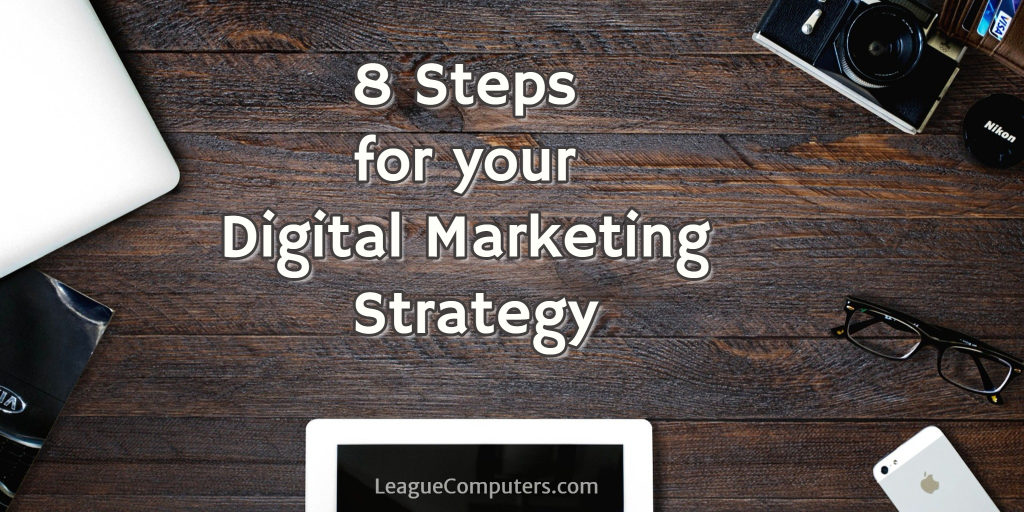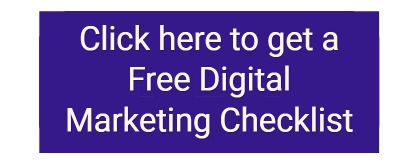
As a small business owner, it’s important to create a digital marketing strategy to have an effective online presence. But you may be wondering how and where to start. Do you really need a website or a blog? How many social media accounts should you use? An important first step is to determine how digital marketing fits into your overall marketing plan. Then use our 8-step checklist below to create a digital marketing strategy.
The term digital marketing simply means that you are marketing your products/services using digital technology, like the internet and/or mobile devices. A digital marketing strategy covers many different types of marketing, including:
- E-Commerce
- Search Engine Marketing
- Search Engine Optimization
- Social Media Marketing
- Email Marketing
- Content Marketing
- Influencer Marketing
Here are 8 steps to help you plan a successful digital marketing strategy:
1. Set Up Your “Owned” Space
This refers to a website/domain for your business and some type of a blog or resources “hub”. Your blog could include videos or a podcast if your target audience responds to them better than written posts. A resources hub is simply a place (page on your website) where you keep the resources you’ve created or collected for your target audience.
By owned, we mean a site that you control; not a platform that could go under tomorrow or a social media site that could shut down your account overnight.
We recommend a self-hosted WordPress site as the quickest and easiest way to set up an owned, online space for your business.
2. Focus on 2 Major Social Media Platforms
Start out with a concentrated focus on 2 sites unless you have in-house staff to help or you outsource management of other sites.
We recommend Facebook and one other site, depending on your target audience.
(1) For most businesses, a Facebook Page has become the standard extension of your website.
(2) Pick one other site that your target audience uses. Do your research if you don’t already know what site they use most.
3. Plan Your Content
You need a plan and a calendar for long-term content marketing success. Consider your answers to the following:
- What kind of content will you create and share with your target audience? If you don’t know where to start, then outline the problem(s) your product/service solve(s), and create content related to those solutions.
- What type of content generates the most engagement from your audience: blog posts, videos, podcasts? If you haven’t created any content yet, then ask current clients or prospective clients, and experiment with several types of content to find the best for your digital strategy.
- How often will you be creating new content, posting content to social media sites, and/or collecting/sharing other people’s content? A long-term plan and a detailed content calendar will help keep all of this organized.
4. Choose Tools & Systems to Run Your Digital Marketing Strategy
There are a wide variety of free and paid tools available, but once you find a few that work for you, stick with them and don’t get side-tracked by every new tool that is released each month.
The tools themselves may serve as the system for running your digital marketing efforts, or you may develop your own internal system based on your business.
In general, you need tools/systems to:
- Create and curate content
- Post content (schedule) consistently
- Monitor social sites and websites
- Respond to your community
- Track and measure your digital marketing
5. Set Up Your Email Marketing
An email list allows you to consistently connect with your most interested prospects, and to build a long-term relationship with them.
You also need to offer an incentive for people to share their email with you: a free report or video series, a low-cost product/service, etc.
6. Do Basic Search Engine Optimization (SEO)
Investing in basic and/or on-going SEO will help your site show up in search results.
A self-hosted WordPress site makes it easier to get started with basic SEO and then depending on your budget, you can put an on-going SEO plan in place immediately or over the next several months.
7. Include Paid Advertising
Going forward, this is becoming a necessity in today’s “noisy” online world.
Set aside some of your marketing budget for online advertising, whether it’s Facebook Ads, Pinterest promoted Pins, Instagram Ads or Google Adwords.
8. Develop A System for Measuring Online Results
Why are you using digital marketing? For brand awareness, leads, foot traffic, sales?
Whatever your digital marketing goals are, you need a system to track, measure, test, and adjust your strategies to get the desired ROI (return on investment).
This can be an Excel spreadsheet or a paid dashboard/tool, but it is important to put something in place that will help you determine what is working, what’s not working, and where to spend more time/money going forward.
——————
Free Resource:
Use our free Digital Marketing Checklist to put a plan in place. Click on the button below to download your copy:

